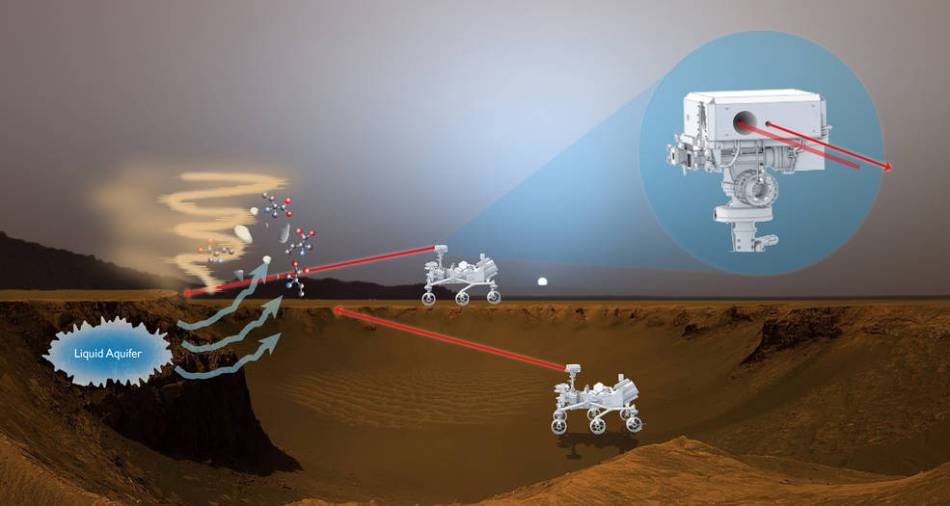Nov 2 2016
 This artist’s rendition shows how a proposed laser-fluorescence instrument could operate on Mars. (Credits: NASA)
This artist’s rendition shows how a proposed laser-fluorescence instrument could operate on Mars. (Credits: NASA)
The U.S. military currently uses a sensing method to remotely monitor the air to detect potentially life-threatening pathogens, toxins, and chemicals. This has inspired the creation of an innovative instrument - the Bio-Indicator Lidar Instrument, or BILI - that is capable of “sniffing” for life on Mars and other targets in the solar system.
Branimir Blagojevic, a NASA technologist at the Goddard Space Flight Center in Greenbelt, Maryland, had earlier worked for a company that developed the sensor. He has used the technology to develop an instrument prototype, and proved during testing that the same remote-sensing technology used to detect bio-risks in public places could also be good at identifying organic bio-signatures on Mars.
BILI is a fluorescence-based lidar, a type of remote-sensing system quite like radar in operation and principle. Rather than using radio waves, lidar instruments use light to detect and ultimately analyze the particle composition in the atmosphere.
As a part of its climate-studies research, NASA has utilized fluorescence instruments for detecting chemicals in atmosphere; however it has never used the method in planetary studies.
NASA has never used it before for planetary ground level exploration. If the agency develops it, it will be the first of a kind.
Branimir Blagojevic, Technologist, NASA
A Rover’s ‘Sense of Smell’
As a planetary-exploration tool, Blagojevic and his team, Goddard researchers Melissa Trainer and Alexander Pavlov, envision BILI as chiefly “a rover’s sense of smell.”
BILI will be positioned on a rover’s mast, and would first scan the terrain searching for dust plumes. Once detected, the instrument would command its two UV lasers to pulse light at the dust.
The illumination would cause the particles within these dust clouds to fluoresce or resonate. By examining the fluorescence, researchers can establish if the dust contained organic particles were produced fairly recently or in the past. The data also would expose the particles’ size.
If the bio-signatures are there, it could be detected in the dust.
Branimir Blagojevic, Technologist, NASA
BILI’s Beauty
Blagojevic states that the key feature of BILI is its ability to identify complex organic materials in small levels from a distance of several hundred meters in real-time. It could autonomously look for bio-signatures in plumes above recurring slopes - areas not easily navigated by a rover carrying a number of in-situ instruments for comprehensive biological and chemical analysis.
As it could perform a ground-level aerosol analysis from a distance, BILI minimizes the risk of sample contamination that could distort the results.
This makes our instrument an excellent complementary organic-detection instrument, which we could use in tandem with more sensitive, point sensor-type mass spectrometers that can only measure a small amount of material at once. BILI’s measurements do not require consumables other than electrical power and can be conducted quickly over a broad area. This is a survey instrument, with a nose for certain molecules.
Branimir Blagojevic, Technologist, NASA
With such an instrument, which also could be fixed on an orbiting spacecraft, NASA could greatly amplify the probability of discovering bio-signatures in the solar system, he added. “We are ready to integrate and test this novel instrument, which would be capable of detecting a number organic bio-signatures,” Blagojevic said. “Our goal is increasing the likelihood of their discovery.”
Long Heritage
Blagojevic plans to develop BILI further by ruggedizing the design, decreasing its size, and proving that it can detect miniature concentrations of a wide range of organic molecules, mainly in aerosols that would be located at the ground level on Mars.
“This sensing technique is a product of two decades of research,” Blagojevic said, referring to the technology developed by his former employer, Science and Engineering Services, LLC.
Blagojevic and his team made use of NASA’s Center Innovation Fund (CIF) to advance the technology. CIF stimulates and encourages innovation and creativity within NASA, targeting less mature, yet new technologies with great potential.